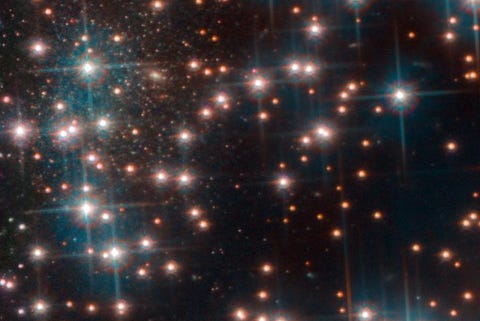Nearby Galaxy Discovered by Accident Lurking Behind a Cluster of Stars
The tiny galaxy is very close, but remained hidden for decades until a group of astronomers spotted it entirely by accident.
By Avery Thompson
ESA/HUBBLE, NASA, BEDIN ET AL.
The Hubble Space Telescope has discovered thousands of galaxies throughout its lifetime, but many of those galaxies are billions of light-years away, in the most distant parts of our visible universe. But the famed space telescope managed to find another galaxy recently. This one is a lot closer, and it was discovered completely by accident.
The researchers were studying a cluster of stars in our own galaxy called NGC 6752. This cluster lies around 13,000 light-years away, and scientists were studying the stars with Hubble to find out how old they are, and in turn, the age of the entire cluster.

The newly-discovered galaxy, Bedin-1, camouflaging itself behind a star cluster.
ESA/HUBBLE, NASA, BEDIN ET AL.
Instead, those scientists discovered something else: an entire galaxy hiding behind this cluster of stars in our galaxy. The galaxy appears to be extremely faint and well hidden, which is why it remained undetected for so long. But it’s also very close: only about 30 million light-years away. That makes it a neighbor, in galactic terms.
The scientists that made this discovery are currently calling the galaxy Bedin 1, after the lead discoverer, Luigi Bedin. Bedin-1 is a small dwarf galaxy not unlike some of the other small dwarf galaxies that orbit the Milky Way, with one big exception: It’s really far away from pretty much everything else. The researchers suspect that Bedin-1 is the most isolated galaxy ever discovered.

A series of images showing just where in the cluster Bedin-1 was discovered.
ESA/HUBBLE, NASA, BEDIN ET AL.
The researchers who discovered Bedin-1 were really lucky to have stumbled on it by accident, because it’s so small and faint it would probably never have been discovered on purpose with current instruments. There’s no telling how many other tiny galaxies are hiding behind star clusters just waiting to be found.
An upcoming NASA telescope, WFIRST, could help find many of those hypothetical hiding galaxies. WFIRST is a telescope specifically designed to scan large chunks of the sky with the same resolution as Hubble, so there’s a much better chance images from WFIRST could help us find even more sneaky galaxies once it’s launched early next decade.
No comments:
Post a Comment